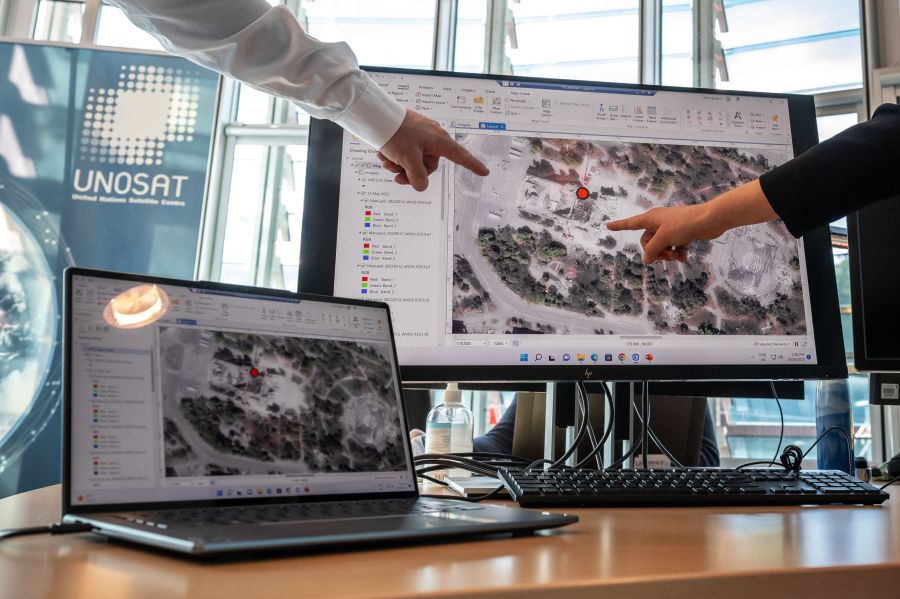How space tech is being deployed in Ukraine

It’s been just over a year since Russia invaded Ukraine, and we’ve been looking at the role technology has played, from government apps repurposed for crowdsourced reconnaissance to wide-scale cyberattacks.
But space-based technology, largely from private companies, is also making a difference in Ukraine.
Marketplace’s Meghan McCarty Carino spoke with Miriam Kramer, senior space reporter for Axios, about how satellites hundreds of miles above the Earth are bringing visibility and transparency to events on the ground. The following is an edited transcript of their conversation.
Miriam Kramer: On one hand, you have Earth-imaging companies like Maxar and Planet and others that are able to take pretty amazingly detailed images of the planet and then in many ways just release them to the public. They aren’t classified, so it acts as this sort of interesting accountability tool. And then the other use of space technology that I think has been widely reported and quite interesting is the use of Starlink. So that’s SpaceX’s satellite internet.
Meghan McCarty Carino: When it comes to these Earth-imaging companies, can you give me an example of how these images have been used in ways that have, you know, kind of affected the war?
Kramer: Yeah, absolutely. So one example that I like to give is, I think in April 2022, there were photos that came out that showed bodies in the streets of the city of Bucha in Ukraine, and these photos were released by Ukrainian forces that had come into the city after Russian forces had pulled out. Russia then claimed that they were staged photos. And actually Maxar released the images, sort of fact checking those Russian claims and showing that they were false. And they even got granular enough to sort of show exactly the part of the street that these images were taken from on the ground. That example, in particular, is pretty telling of just how powerful these tools can be.
McCarty Carino: Right, and because that incident had a pretty powerful effect on kind of public perception fairly early on in this conflict.
Kramer: Absolutely. Yeah. I mean, I think that having a space company, in many ways, being able to release these images and to, you know, not necessarily be a government actor — obviously, being affiliated in some way with the government there, Maxar is an American company — but at the same time, I think that it lended this interesting credibility to it too. That like, hey, this private company didn’t have to do this and yet they released these images.
McCarty Carino: How new is a role like this for space technology in conflict?
Kramer: Space technology has played a role in wars for quite some time. The first Gulf War has been referred to, sort of in the space community, as the first space war through spy satellites, through situational awareness, like the ability to see things from above without flying a drone or a plane above a conflict area is a very powerful thing to be able to do. But Gen. John Raymond, [who was] the head of the Space Force, actually has said that the Ukraine war is the first time that commercial space companies have really played a significant role. So through the commercialization of space more broadly, we have been seeing a lot of companies and governments collaborate with one another, a lot of, you know, big money contracts, that kind of thing, coming through. But now you’re starting to see it affect war. You’re starting to see these companies actually being able to play a role in conflict that wasn’t necessarily available in earlier conflicts.
McCarty Carino: And why is that piece significant, that these are private commercial companies in many cases?
Kramer: It can get pretty complicated. Recently, SpaceX has said that they’re limiting the use of Starlink in Ukraine after it was revealed that Ukrainian forces were using it to be able to operate drones on the battlefield. SpaceX sees Starlink as civilian enterprise, it’s civilian use cases, that kind of thing. So I think that when it’s translated into war, I mean, war is not just posting things on social media and showing photos of what’s happening in the war on the ground, like, people are dying. And Ukrainian forces are using every tool they have to their advantage, and one of those tools is Starlink. So I think that that’s where things get kind of complicated because if you have a government actor that’s sort of managing these assets, it’s a government. They aren’t beholden to shareholders, they are doing things based on what they see as the big picture, as opposed to these companies that, you know, are doing things out of altruism, but maybe the “nitty gritty” or whatever it might be when it comes to war, you know, can be a difficult thing to kind of reckon with when it’s your technology being used.
McCarty Carino: And then on the flip side, it also opens up these companies and their technology as targets for retaliation.
Kramer: Yeah, absolutely. And Russian officials have made clear that they see commercial assets that are being used in times of war to aid in a war effort, they see those as legitimate targets potentially. Now, no satellite has been shot down. That has not happened, but, you know, we’ve heard reports of cyberattacks on satellites, which are happening a lot. And it’s an interesting position to sort of be placed in as a private company to, you know, potentially be targeted by foreign actors because of the work you’re doing with other nations.
McCarty Carino: So where do you see this going? Do you think the role and the use of space technology in armed conflicts like this is going to expand?
Kramer: Yeah, I mean, I feel like this is sort of only just the beginning of kind of what these tools can do. The U.S. government, in particular, has already taken notice. A lot of these companies, even before the war, had contracting work and deals with the [National Security Agency] and other agencies to kind of provide imagery as needed to give them data that they could work with and see value in. And I think that this really shows just how valuable that data can be. It’s also a new avenue for transparency, I think, to be able to see these unclassified images. I mean, just the ability to see photos from space is a relatively new thing, I think, for a lot of folks to be able to, you know, as a journalist, even go to Maxar, go to Planet, and say, like, “Hey, do you have images in this time frame of this place? I’m really curious what it looks like.” And that’s useful for something like a natural disaster too. That’s not just for conflict. So we’re just sort of starting to see the beginning of how these tools can be used.
Related links: More insight from Meghan McCarty Carino
A recent report from the Organization for Economic Cooperation and Development, a major intergovernmental organization, gets into more detail on how the war is influencing “space activities,” from the real-time satellite images of troop movements that Kramer covered in her piece to things like monitoring food supplies and crop conditions in the area.
It also points out that the conflict could have a big effect on international cooperation in space, something that’s pretty important for coordinating what they call orbital resources, because even up there, space is still limited and it’s getting crowded with debris.
The OECD notes that Russia accounts for the lion’s share of space debris, which could cause collisions and totally disrupt all this useful space tech we’re talking about, not to mention human spaceflight.
The future of this podcast starts with you.
Every day, the “Marketplace Tech” team demystifies the digital economy with stories that explore more than just Big Tech. We’re committed to covering topics that matter to you and the world around us, diving deep into how technology intersects with climate change, inequity, and disinformation.
As part of a nonprofit newsroom, we’re counting on listeners like you to keep this public service paywall-free and available to all.
Support “Marketplace Tech” in any amount today and become a partner in our mission.


















